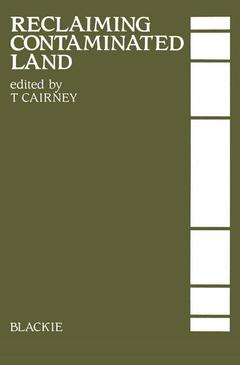Description
Reclaiming Contaminated Land, Softcover reprint of the original 1st ed. 1987
Author: Cairney T.
Language: English
Publication date: 02-2012
260 p. · 15.2x22.9 cm · Paperback
260 p. · 15.2x22.9 cm · Paperback
Description
/li>Contents
/li>
Chemically contaminated land has only recently been recognized as an immediate or long-term potential hazard, and published guidance on how to tackle such land has been sparse. Indeed much of the available technical work emphasizes the risks and dangers, rather than indicating safe and economical strategies of reclamation. This book provides a comprehensive treatment of the important aspects of land reclamation. Its basic aim is to dispel the myths that have become associated with the subject and to indicate methods and strategies that can be used for safe and economical reclamation. The authors concentrate on the more important facets of reclamation and indicate where advice and information is more or less certain. As in any newly developed field there are still uncertainties and, for this reason, not all the chapters contain equivalent amounts of detail. All the authors have expertise in the field of land reclamation, and differences in emphasis between authors reflect the present state of the subject. Overall, the book emphasizes that contaminated land can be reclaimed safely provided that sufficient attention is paid to detail and that the proposed end use of the land is appropriate and based on a detailed knowledge of the site.
1 Recognition of the problem.- 1.1 Introduction.- 1.2 National response to contaminated land in the UK.- 1.3 National response to contaminated land in Europe and North America.- References.- 2 Types of contaminated land.- 2.1 Introduction.- 2.2 Transportation of contamination.- 2.3 Main sources of land contamination.- 2.4 Conclusions.- References.- 3 Main types of contaminants.- 3.1 Introduction.- 3.2 Metallic contaminants.- 3.3 Inorganic contaminants.- 3.4 Organic contaminants.- 3.5 Asbestos.- 3.6 Combustible materials.- 3.7 Gases.- 3.8 Other contaminants.- References.- 4 Appropriate site investigations.- 4.1 Introduction.- 4.2 Recognition that an investigation is needed and establishment of the basis for that investigation.- 4.3 Design of site sampling/analytical programme.- 4.4 On-site sampling, observation and testing.- 4.5 Analysis of material taken from the site.- 4.6 Interpretation of analytical data.- References.- 5 Available reclamation methods.- 5.1 Introduction.- 5.2 The land use option.- 5.3 General considerations.- 5.4 The options.- 5.5 Excavation.- 5.6 Soil treatment after excavation.- 5.7 In-situ treatment.- 5.8 Macro-encapsulation/isolation.- 5.9 Covering systems.- 5.10 Execution of reclamation works.- 5.11 Monitoring and evaluation of performance.- 5.12 Guidance available.- References.- 6 Soil cover reclamations.- 6.1 Introduction.- 6.2 Performance requirements for soil cover reclamations.- 6.3 The contaminant problem.- 6.4 Pathways for contaminant migration.- 6.5 Groundwater and soil moisture movements.- 6.6 Choice of soil cover materials.- 6.7 The design of soil cover reclamations.- 6.8 Summary.- References.- 7 Long-term monitoring of reclaimed sites.- 7.1. Introduction.- 7.2 Established precedents for monitoring.- 7.3 Questions on the long-term effectiveness of reclamation options.- 7.4 Monitoring systems and methods.- 7.5 Organization control of monitoring.- 7.6 Summary.- References.- 8 Safety in site reclamation.- 8.1 Introduction.- 8.2 Nature of hazards.- 8.3 Protection against hazards.- 8.4 Safety procedures.- 8.5 Conclusions.- 8.6 Appendix: environmental health and safety guide for construction site staff (an example).- References.- 9 Policy, planning and financial issues.- 9.1 Introduction.- 9.2 Controlling the development of contaminated land.- 9.3 Land-use planning and control.- 9.4 Public health legislation and development control.- 9.5 Financial resources.- References.- 10 Landscaping and vegetating reclaimed sites.- 10.1 Introduction.- 10.2 Requirements of plants.- 10.3 Physical support for plants.- 10.4 Compaction.- 10.5 Water supply and storage.- 10.6 Plant nutrients.- 10.7 Grassland establishment.- 10.8 Grass seed mixtures.- 10.9 Grass cutting.- 10.10 Wild species.- 10.11 Trees and shrubs.- 10.12 Timing.- 10.13 Plant and soil interactions.- 10.14 Conclusions.- References.- 11 Hazards from methane (and carbon dioxide).- 11.1 Introduction.- 11.2 Relevant gases and their principal characteristics.- 11.3 Gas flow in and from landfill sites.- 11.4 Gas measurement.- 11.5 Gas control measures.- 11.6 Hazards in buildings.- 11.7 Effects on plants.- Acknowledgement.- References.
© 2024 LAVOISIER S.A.S.




